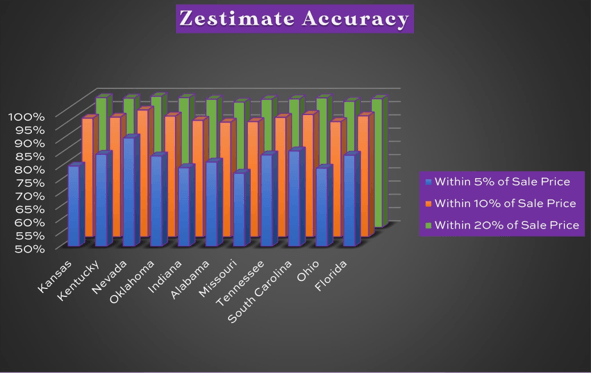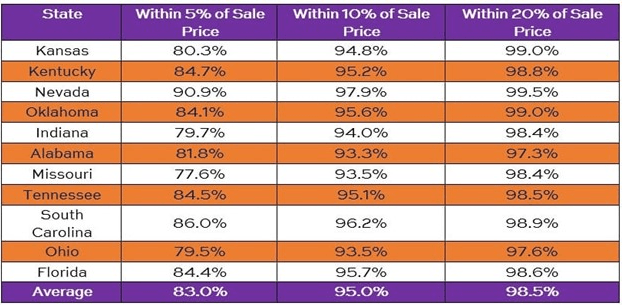Meet John Tallarigo. John is the education content developer and is working on expanding PREC coursework into new states and additional courses for our current states. His interest in property law led him to get his real estate license while studying for the bar exam! John is a graduate of NKU Chase College of Law '16 and earned his undergraduate degree from Northern Kentucky University '11. He loves the Cincinnati Bengals!
Can I Rely on Zillow's Estimated Values?

What is going on with home prices? As someone who is going to be buying a house in the next few months, I can’t help but wonder, “are these home prices right?” It’s harder and harder to tell given the amount of information available to your everyday consumer. More and more companies like Zillow and Redfin like to throw an estimate on the value of a house to provide an impression that they know what they are talking about or that they know something that agents don’t.
As I browse these sites to get an idea of what I should expect when I actually start looking for houses (as if the market will be the same in 3 months, HA!), I keep asking myself the same questions, “Is that estimate right?”, “Is this what I’m going to have to pay?”, and “Is this what I’m getting for my money?” Questions I’m sure you and your clients have all asked or will ask at some point.
When I google “best house estimate” the results list has homelight.com, a few local home value estimator websites, and bobvila.com (Who remembers him from Home Improvement? What about This Old House?) But the almighty and omniscient Google has Zillow as the best home valuation tool, followed by Redfin, Trulia, and Re/Max, in that order.
So, let’s look at how Zillow creates their Zestimate and how accurate those numbers are compared to sale prices.
THE ZESTIMATE
Zillow’s Zestimate is an automated algorithm designed to estimate a home’s market value. The algorithm is designed to adjust with every home sale and market trend. It incorporates publicly available information, information obtained through multiple listing services, information provided by users, and, of course, location. Inflation will affect the accuracy, as well as non-market related global happenings like the Russian invasion of Ukraine.
It’s a proprietary tool. I can’t tell you how exactly it works because 1) that’s most likely a trade secret and not available to the public, and 2) I am not a computer whiz, a tech genius, and never worked at Zillow, so just be glad I spelled “algorithm” correctly.
HOW ACCURATE IS THE ZESTIMATE?
According to Zillow , the Zestimate has a nationwide median error rate for homes on the market of 1.9%. This means that the Zestimates for half of all on-market homes are within 2% of the selling price, and half are not.
This of course varies from state to state and even across the major metropolitan areas. For example, the median error rate of the Zestimate in Fort Collins, Colorado is 1.2% and the median error rate in Seattle, Washington is 3.3%. That’s thousands of dollars off from the sale price. But does the error rate of the estimate tell us how accurate it really is? Maybe not.
Zillow also publishes what percentage of home sales do the Zestimates fall within 5%, 10%, and 20% of the sale price. Let’s look at some of the markets that affect our Perry students and the raw data Zillow published on each.


(Data pulled from Zillow.com.)
For states that affect most Perry Students, the Zestimate is only accurate within 5% of the sales prices on 83.0% of the houses. The Zestimate is almost 99% accurate when you expand the results to allow accuracy to reflect up to 20% from the sale prices. An important note about this data: this is only reflective of houses on the market at the time of the Zestimate; Zestimates of off-market houses are way more inaccurate!
Let’s briefly consider the real-world implications of these numbers. On a $300,000 house, 5% is a matter of $15,000, which is not a small bag of dough for your clients. Zillow is telling us that 83% of the time, the Zestimate on that client’s former home or new home is going to be within $15,000 of the sale price.
A lot of other factors play into the sale price that an algorithm cannot measure definitively every time. How motivated a seller is to sell, how motivated the buyer is to move, closing costs, whether a bathroom needs to be redone, etc., all play into the sale price. The Zestimate may be trusted by people not using agents more than those who do use agents. But it’s going to be your job to know just how accurate that number is and how to reconcile that number with your clients.
One of the biggest challenges of working in real estate is managing the expectations of the people you work with. In a client’s or customer’s eyes, the Zestimate can sometimes be an anchor for your transaction. Knowing how they come up with that number is key to knowing how to move that anchor to get the transaction completed and make your clients happy.
About the Author
Recent Posts
Let's Stay Connected
Follow us on and become part of the PREC community
Never miss a tweet by connecting with us on Twitter
Check our our posts about trends in real estate industry and market










